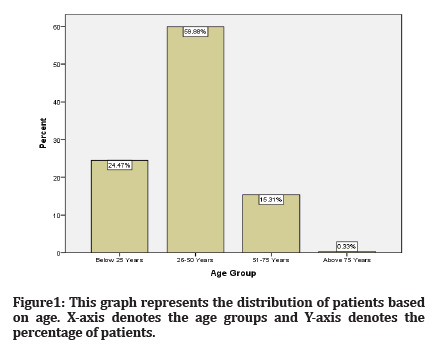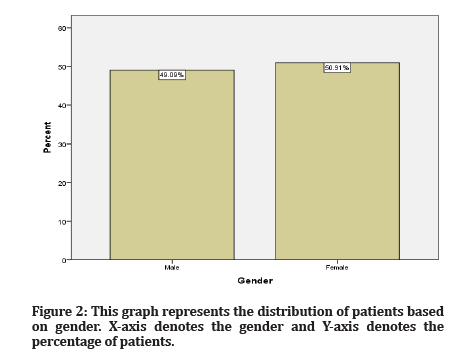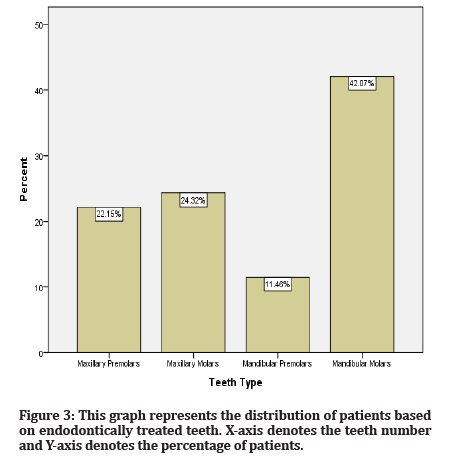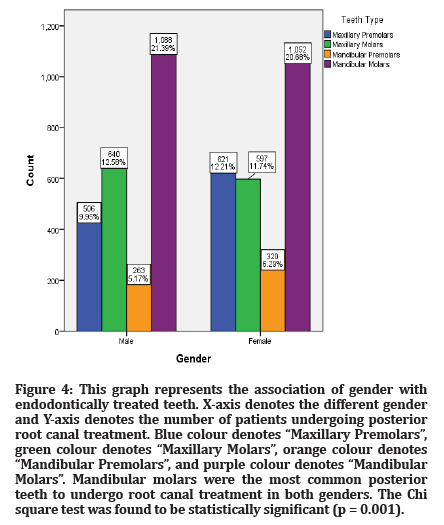Research - (2022) Volume 10, Issue 5
Incidence of Root Canal Treatment in Posterior Teeth and its Association with the Gender - A Retrospective Study
*Correspondence: Anjaneyulu, Department of Aesthetic dentistry, Saveetha University, Saveetha Institute of Medical and Technical Science, Chennai, India, Email:
Abstract
Introduction: Root canal therapy is an efficacious therapeutic strategy to retain teeth with irreversible pulpal damage. Root canal treatment ensures that teeth with irreversible pulpal damage retain their functional role in the oral cavity. Hence the aim of the study is to determine the incidence of root canal treatment in anterior teeth and its association with the gender.
Materials and method: The data of patients reporting to Saveetha Dental College and Hospitals was reviewed and patients with endodontically treated teeth were selected for the study. It included parameters like age, gender, and endodontically treated teeth type. Chi square tests were carried out using gender as independent variables and endodontically treated teeth number as dependent variable. The statistical analysis was done by Pearson chi square test. P value < 0.05 was considered statistically significant.
Results: Majority (59.8%) of patients was between the age group of 26-50 years, and females (51%) had a slight predominance over males (49%). The most common posterior teeth to undergo root canal treatment were mandibular molars which accounted for approximately 42% of the RCTs among both genders. The Chi square test value was found to be statistically significant (0.001) Conclusion: Majority of the patients undergoing posterior root canal treatment were females, and mandibular molars were the most common posterior teeth to undergo root canal treatment among both the genders.
Keywords
Aesthetic, Dental caries, Endodontics, Novel technique, Pulpitis, Trauma
Introduction
Dental caries is the most common infectious disease of childhood and adolescence and is rated the highest among dental problems [1]. Caries prevalence has increased in the last four decades [2]. If the cariogenic environment persists in the oral cavity, the newly erupted permanent teeth may get decayed [3]. Young permanent teeth have wide dentinal tubules, a large pulp chamber, and high pulp horns, shortening the distance for decay to reach the pulp [4]. If not treated early, infection of the dental pulp will eventually occur [5].
Treatment of pulpal infection in permanent teeth in children and young adults presents a unique challenge to dental clinicians [6]. Tooth preservation is the ultimate goal of modern dental care and root canal therapy (RCT) is an available, efficacious therapeutic strategy to retain teeth. Root canal treatment also known as endodontic treatment is one of the most technically demanding procedures and a very specialized aspect in restorative dentistry requiring a high level of technical skills [7]. It involves a series of steps to aid in clinical decision making. A reliable preoperative diagnosis with radiographic assessment is essential [8]. This will enable correct determination of the desired working length during canal preparation, master gutta percha and obturation. Thus many aspects of RCT such as instruments, medicaments and materials have been developed and modified. Many studies regarding cleaning and shaping techniques quoted that commonly applied techniques were step-back, crown-down and double-flare technique [9-11]. These techniques were chosen as they removed the bulk of micro-organisms which harbour at the apical area [12].
Endodontic treatment will ensure that a diseased tooth or root retains its functional role in the oral cavity [13]. The reasons for prescribing endodontic treatments are mainly related to complications of dental caries. Studies have shown that toothache and dental abscess were the commonest complaints given by patients demanding for RCT [14,15].
Since the prominent factors necessitating RCT are caries related, it is therefore not surprising to observe that the pattern of provision of RCT with respect to the teeth involved tends to follow the reported order of susceptibility of teeth to caries : mandibular second molars being the most susceptible teeth; followed by maxillary first and second molars and mandibular first molars; maxillary and mandibular second premolars; maxillary and mandibular first premolars; maxillary central and lateral incisors; and maxillary and mandibular canines, with mandibular central and lateral incisors being the least susceptible teeth [16,17].
There are limited epidemiological studies relating to the pattern of demand of RCT in India particularly in the southern part of the country. Information on reasons and patterns of demand for treatment is necessary for understanding disease patterns as well as for devising optimal preventive and management strategies. Our team has extensive knowledge and research experience that has translate into high quality publications [18-37].
Hence the aim of this study is to determine the incidence of root canal treatment in posterior teeth and their association with gender among patients attending a private dental college and hospital in Chennai.
Materials and Method
Study design and study setting
The present study was conducted in a university setting (Saveetha dental college and hospitals, Chennai, India). Thus the data available is of patients from the same geographic location and have similar ethnicity. The retrospective study was carried out with the help of digital case records of 5087 patients who reported to the hospital. Ethical clearance to conduct this study was obtained from the Scientific Review Board of the hospital.
Sampling
Data of 5087 patients were reviewed and then extracted. All patients with endodontically treated posterior teeth in the given duration of time period were evaluated. Only relevant data was included to minimize sampling bias. Simple random sampling method was carried out. Cross verification of data for error was done by the presence of additional reviewers and by photographic evaluation. Incomplete data collection was excluded from the study.
Data collection
A single calibrated examiner evaluated the digital case records of patients who reported to Saveetha Dental College from June 2019 to june 2021. For the present study, inclusion criteria were data of patients with endodontically treated anterior teeth. Data obtained were age, gender and endodontically treated teeth number. All obtained data were tabulated into Microsoft excel documents.
Statistical analysis
The collected data was tabulated and analysed with Statistical Package for Social Sciences for Windows, version 20.0 (SPSS Inc., Vancouver style) and results were obtained. Categorical variables were expressed in frequency and percentage. Chi square test was used to test association between categorical variables. Chi square tests were carried out using gender as an independent variable and endodontically treated teeth number as a dependent variable. The statistical analysis was done by pearson chi square test. P value < 0.05 was considered statistically significant.
Results
In our study, the majority (59.8%) of the patients undergoing posterior root canal treatment were between 26-50 years of age (Figure 1).

Figure 1: This graph represents the distribution of patients based on age. X-axis denotes the age groups and Y-axis denotes the percentage of patients.
Females had a slight predominance (50.9%) undergoing posterior root canal treatment over males (49.1%) (Figure 2).

Figure 2:This graph represents the distribution of patients based on gender. X-axis denotes the gender and Y-axis denotes the percentage of patients.
Mandibular molars (42%) were the most common posterior teeth to undergo root canal treatment, followed by maxillary molars (24.2%) (Figure 3).

Figure 3:This graph represents the distribution of patients based on endodontically treated teeth. X-axis denotes the teeth number and Y-axis denotes the percentage of patients.
On associating gender with the teeth number, mandibular molars were the most common posterior teeth to undergo root canal treatment in both genders. The Chi square value was found to be statistically significant (0.001) (Figure 4).

Figure 4:This graph represents the association of gender with endodontically treated teeth. X-axis denotes the different gender and Y-axis denotes the number of patients undergoing posterior root canal treatment. Blue colour denotes â??Maxillary Premolarsâ?, green colour denotes â??Maxillary Molarsâ?, orange colour denotes â??Mandibular Premolarsâ?, and purple colour denotes â??Mandibular Molarsâ?. Mandibular molars were the most common posterior teeth to undergo root canal treatment in both genders. The Chi square test was found to be statistically significant (p = 0.001).
Discussion
Dental caries is the most common infectious disease of childhood and adolescence and is rated the highest among dental problems [1]. If not treated early, infection of the dental pulp will eventually occur [5]. Treatment of pulpal infection in permanent teeth in children and young adults presents a unique challenge to dental clinicians [6].
Tooth preservation is the ultimate goal of modern dental care and root canal therapy (RCT) is an available, efficacious therapeutic strategy to retain teeth. Root canal treatment also known as endodontic treatment is one of the most technically demanding procedures and a very specialized aspect in restorative dentistry requiring a high level of technical skills [7].
About 51% of the patients encountered in this study were females. Similar findings were recorded by Hollanda et al, and Boucher et al and various other studies [38-40]. Females had been reported to be more concerned about their breath and oral health; hence they appeared to be better motivated to demand for oral health care [38,41].
Though Osama et al and Wayman et al reported higher demand for endodontic treatment by male patients [14,42].
Most of the patients that presented were found in the 26-50 years age group. This can be partly attributed to the location of our hospital which is in a university environment with a huge students’ population. Another possible reason is the high prevalence of dental caries often reported among young and middle aged adults [43]. Patients in their 3rd and 4th decades have been observed to present more for dental treatment [44]. Our result therefore, is in agreement with that of Farrel and Burke, [45] who showed that the highest incidence of endodontic treatment was performed among patients between 21-30 years age group.
In our study, mandibular molars (42%) were the most common teeth undergoing root canal treatment followed by maxillary molars (24.3%). This agrees with the findings of Ridell et al, and Wayman et al [42,46]. The most probable reason was that the mandibular first molar is the first tooth to erupt in the oral cavity; hence it was more prone to caries. In addition, the mandibular molars are more susceptible to food stagnation than the maxillary molars. This indicates to the fact that preventive measures for lower molars are extremely necessary.
Root canal treatments were more frequently undertaken in mandibular teeth than maxillary teeth in our study. This pattern is in contrast with that of Scavo et al [47] and Al-Negrish [48] who reported that 55.69% and 77.7% of their RCTs were performed in maxillary teeth respectively. This could be related to the aesthetic reason, as the upper teeth appear more prominent than the lower teeth during a smile, making the patient more interested in preserving the upper teeth.
Limitations of this study are smaller sample size, and geographical limitations. Further studies with larger sample size and a greater geographical aspect can help in better diagnosis and further treatment planning for endodontic treatments.
Conclusion
Majority of the patients undergoing posterior root canal treatment were females, and mandibular molars were the most common posterior teeth to undergo root canal treatment among both the genders.
Acknowledgement
The authors sincerely acknowledge the faculty Medical record department and Information technology department of SIMATS for their tireless help in sorting out data’s pertinent to this study.
Funding
The present project is supported/funded/sponsored by Saveetha Institute of Medical and Technical Sciences, Saveetha Dental College and Hospitals, Saveetha University contributed by Southern Engineering Co Ltd.
Conflict of Interest
None.
References
- Bagramian RA, Garcia-Godoy F, Volpe AR. The global increase in dental caries. A pending public health crisis. Am J Dent 2009; 22:3-8.
- Mortazavi M, Mesbahi M, Azar MR, et al. MTA Pulpotomy in Primary Molars, A Prospective Study. Res J Biol Sci 2009; 4:1-5.
- Carrotte P. Endodontic treatment for children. Br Dent J 2005; 198:9-5.
- Ingle JI, Backland LK. Endodontics. BC Decker Inc. Loma Linda, California p503-505 2002.
- Martin FE. Carious pulpitis: microbiological and histopathological considerations. Aust Endod J 2003; 29:134-7.
- Gruythuysen RJM, Van Strijp AJP, Wu M-K. Long-term survival of indirect pulp treatment performed in primary and permanent teeth with clinically diagnosed deep carious lesions. J Endod 2010; 36:1490-3.
- Al-Madi EM, Al Saleh SA, Bukhary SM, et al. Endodontic and Restorative Treatment Patterns of Pulpally Involved Immature Permanent Posterior Teeth. Int J Dent 2018: 2178535.
- Gutmann JL, Dumsha TC, Lovdahl PE. Problem Solving in Endodontics: Prevention, Identification, and Management, 4th edn. St Louis, MO 2005.
- Ahmed MF, Elseed AI, Ibrahim YE. Root canal treatment in general practice in Sudan. Int Endod J 2000; 33:316-9.
- Aziz ZAC, Abdullah M, Vello CDS, et al. General dental practitioners’ knowledge and practice on root canal treatment. Ann Dent UM 2006; 13:12-7.
- Weine FS, Kelly RF, Lio PJ. The effect of preparation procedures on original canal shape and on apical foramen shape. J Endod 1975;1:255-62.
- Peak JD, Hayes SJ, Bryant ST, et al. The outcome of root canal treatment. A retrospective study within the armed forces (Royal Air Force). Br Dent J 2001; 190:140-4.
- Ismail NM, Ismail AR, War WN. Root canal treatment in Hospital Universiti Sains Malaysia Dental Clinic–a 5-year retrospective study. Arch Orofac Sci 2008; 3:23-8.
- Osama K, Alia A, Adil S, et al. Reasons for carrying out root canal treatment-A study. Pak Oral Dent J 2009; 29:107-10.
- Boykin MJ, Gilbert GH, Tilashalski KR, et al. Incidence of endodontic treatment: A 48-Month Prospective Study. J Endod 2003; 29:806-9.
- Hopcraft MS, Morgan MV. Pattern of dental caries experience on tooth surfaces in an adult population. Community Dent Oral Epidemiol 2006; 34:174-83.
- Macek MD, Beltrán-Aguilar ED, Lockwood SA, et al. Updated comparison of the caries susceptibility of various morphological types of permanent teeth. J Public Health Dent 2003; 63:174-82.
- Muthukrishnan L. Imminent antimicrobial bioink deploying cellulose, alginate, EPS and synthetic polymers for 3D bioprinting of tissue constructs. Carbohydr Polym 2021; 260:117774.
- PradeepKumar AR, Shemesh H, Nivedhitha MS, et al. Diagnosis of Vertical Root Fractures by Cone-beam Computed Tomography in Root-filled Teeth with Confirmation by Direct Visualization: A Systematic Review and Meta-Analysis. J Endod 2021; 47:1198-214.
- Chakraborty T, Jamal RF, Battineni G, et al. A Review of Prolonged Post-COVID-19 Symptoms and Their Implications on Dental Management. Int J Environ Res Public Health 2021;18.
- Muthukrishnan L. Nanotechnology for cleaner leather production: A Review. Environ Chem Lett 2021; 19:2527-49.
- Teja KV, Ramesh S. Is a filled lateral canal - A sign of superiority? J Dent Sci 2020; 15:562-3.
- Narendran K, Jayalakshmi, Ms N, et al. Synthesis, characterization, free radical scavenging and cytotoxic activities of phenylvilangin, a substituted dimer of embelin. Indian J Pharm Sci 2020; 82.
- Reddy P, Krithikadatta J, Srinivasan V, et al. Dental Caries Profile and Associated Risk Factors Among Adolescent School Children in an Urban South-Indian City. Oral Health Prev Dent 2020; 18:379-86.
- Sawant K, Pawar AM, Banga KS, et al. Dentinal Microcracks after Root Canal Instrumentation Using Instruments Manufactured with Different NiTi Alloys and the SAF System: A Systematic Review. NATO Adv Sci Inst Ser E Appl Sci 2021; 11:4984.
- Bhavikatti SK, Karobari MI, Zainuddin SLA, et al. Investigating the Antioxidant and Cytocompatibility of Mimusops elengi Linn Extract over Human Gingival Fibroblast Cells. Int J Environ Res Public Health 2021; 18.
- Karobari MI, Basheer SN, Sayed FR, et al. An In Vitro Stereomicroscopic Evaluation of Bioactivity between Neo MTA Plus, Pro Root MTA, BIODENTINE & Glass Ionomer Cement Using Dye Penetration Method. Materials 2021; 14.
- Rohit Singh T, Ezhilarasan D. Ethanolic Extract of Lagerstroemia Speciosa (L.) Pers., Induces Apoptosis and Cell Cycle Arrest in HepG2 Cells. Nutr Cancer 2020; 72:146-56.
- Ezhilarasan D. MicroRNA interplay between hepatic stellate cell quiescence and activation. Eur J Pharmacol 2020; 885:173507.
- Romera A, Peredpaya S, Shparyk Y, et al. Bevacizumab biosimilar BEVZ92 versus reference bevacizumab in combination with FOLFOX or FOLFIRI as first-line treatment for metastatic colorectal cancer: a multicentre, open-label, randomised controlled trial. Lancet Gastroenterol Hepatol 2018; 3:845-b55.
- Raj RK. β-Sitosterol-assisted silver nanoparticles activates Nrf2 and triggers mitochondrial apoptosis via oxidative stress in human hepatocellular cancer cell line. J Biomed Mater Res A 2020; 108:1899-908.
- Vijayashree Priyadharsini J. In silico validation of the non-antibiotic drugs acetaminophen and ibuprofen as antibacterial agents against red complex pathogens. J Periodontol 2019; 90:1441-8.
- Priyadharsini JV, Vijayashree Priyadharsini J, et al. In silico analysis of virulence genes in an emerging dental pathogen A. baumannii and related species. Arch Oral Biol 2018; 94:93-8.
- Uma Maheswari TN, Nivedhitha MS, Ramani P. Expression profile of salivary micro RNA-21 and 31 in oral potentially malignant disorders. Braz Oral Res 2020; 34:e002.
- Gudipaneni RK, Alam MK, Patil SR, et al. Measurement of the Maximum Occlusal Bite Force and its Relation to the Caries Spectrum of First Permanent Molars in Early Permanent Dentition. J Clin Pediatr Dent 2020; 44:423-8.
- Chaturvedula BB, Muthukrishnan A, Bhuvaraghan A, et al. Dens invaginatus: a review and orthodontic implications. Br Dent J 2021; 230:345-50.
- Kanniah P, Radhamani J, Chelliah P, et al. Green synthesis of multifaceted silver nanoparticles using the flower extract of Aerva lanata and evaluation of its biological and environmental applications. ChemistrySelect 2020; 5:2322-31.
- Hollanda ACB, De Alencar AHG, Estrela CR de A, et al. Prevalence of endodontically treated teeth in a Brazilian adult population. Braz Dent J 2008; 19:313-7.
- Manga P, Charette A. The patterns and determinants of the utilization of dental care services in Canada. Can J Public Health 1986; 77:119-23.
- Boucher Y, Matossian L, Rilliard F, et al. Radiographic evaluation of the prevalence and technical quality of root canal treatment in a French subpopulation. Int Endod J 2002; 35:229-38.
- De Quadros I, Gomes BPFA, Zaia AA, et al. Evaluation of endodontic treatments performed by students in a Brazilian Dental School. J Dent Educ 2005; 69:1161-70.
- Wayman BE, Patten JA, Dazey SE. Relative frequency of teeth needing endodontic treatment in 3350 consecutive endodontic patients. J Endod 1994; 20:399-401.
- Nongkynrih B, Mathur V, Patro B, et al. Prevalence of dental caries among adults and elderly in an urban resettlement colony of New Delhi. Indian J Dent Res 2008; 19:95.
- Oginni AO. Dental care needs and demands in patients attending the dental hospital of the Obafemi Awolowo University Teaching Hospital’s Complex Ile-Ife, Nigeria. Niger J Med 2004; 13:339-44.
- Farrell TH, Burke FJ. Root canal treatment in the General Dental Service 1948-1987. Br Dent J 1989; 166:203-8.
- Ridell K, Sundin B, Matsson L. Endodontic treatment during childhood and adolescence. A survey of 19-year-olds living in the city of Malmö, Sweden. Swed Dent J 2003; 27:83-9.
- Scavo R, Martinez Lalis R, Zmener O, et al. Frequency and distribution of teeth requiring endodontic therapy in an Argentine population attending a specialty clinic in endodontics. Int Dent J 2011; 61:257-60.
- Al-Negrish ARS. Incidence and distribution of root canal treatment in the dentition among a Jordanian sub population. Int Dent J 2002; 52:125-9.
Indexed at, Google Scholar, Cross Ref
Indexed at, Google Scholar, Cross Ref
Indexed at, Google Scholar, Cross Ref
Indexed at, Google Scholar, Cross Ref
Indexed at, Google Scholar, Cross Ref
Indexed at, Google Scholar, Cross Ref
Indexed at, Google Scholar, Cross Ref
Indexed at, Google Scholar, Cross Ref
Indexed at, Google Scholar, Cross Ref
Indexed at, Google Scholar, Cross Ref
Indexed at, Google Scholar, Cross Ref
Indexed at, Google Scholar, Cross Ref
Indexed at, Google Scholar, Cross Ref
Indexed at, Google Scholar, Cross Ref
Indexed at, Google Scholar, Cross Ref
Indexed at, Google Scholar, Cross Ref
Indexed at, Google Scholar, Cross Ref
Indexed at, Google Scholar, Cross Ref
Indexed at, Google Scholar, Cross Ref
Indexed at, Google Scholar, Cross Ref
Indexed at, Google Scholar, Cross Ref
Indexed at, Google Scholar, Cross Ref
Indexed at, Google Scholar, Cross Ref
Indexed at, Google Scholar, Cross Ref
Indexed at, Google Scholar, Cross Ref
Indexed at, Google Scholar, Cross Ref
Indexed at, Google Scholar, Cross Ref
Indexed at, Google Scholar, Cross Ref
Indexed at, Google Scholar, Cross Ref
Indexed at, Google Scholar, Cross Ref
Indexed at, Google Scholar, Cross Ref
Indexed at, Google Scholar, Cross Ref
Indexed at, Google Scholar, Cross Ref
Indexed at, Google Scholar, Cross Ref
Author Info
Department of Aesthetic dentistry, Saveetha University, Saveetha Institute of Medical and Technical Science, Chennai, IndiaCitation: Aditya Jain, Anjaneyulu, Incidence of Root Canal Treatment in Posterior Teeth and its Association with the Gender - A Retrospective Study, J Res Med Dent Sci, 2022, 10 (5):41-45.
Received: 29-Apr-2022, Manuscript No. JRMDS-22-60232; , Pre QC No. JRMDS-22-60232 (PQ); Editor assigned: 02-May-2022, Pre QC No. JRMDS-22-60232 (PQ); Reviewed: 16-May-2022, QC No. JRMDS-22-60232; Revised: 20-May-2022, Manuscript No. JRMDS-22-60232 (R); Published: 27-May-2022
